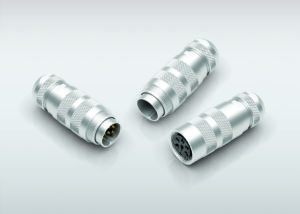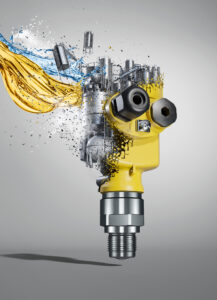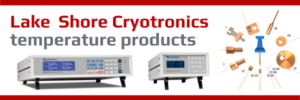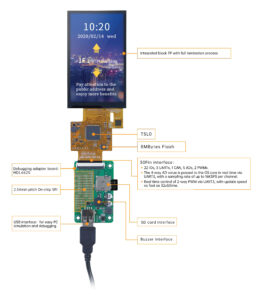 Advantageous under harsh, confined conditions: The short version of the binder M16 series 423 is ideal for use in particularly space-critical applications. The shieldable circular connectors with screw locking that meet the IP67 acquirements when mated are suitable for typical, interference-prone industrial environments.
Advantageous under harsh, confined conditions: The short version of the binder M16 series 423 is ideal for use in particularly space-critical applications. The shieldable circular connectors with screw locking that meet the IP67 acquirements when mated are suitable for typical, interference-prone industrial environments.
binder, a leading supplier of industrial circular connectors, announces the launch of a short version of the 423 series: circular connectors in the M16 form factor with a length of approximately 47 mm. These are available as 2-pin to 19-pin variants and meet IP67 requirements when mated. The product launch concerns short, shieldable cable plugs and sockets, each with cable clamp, in both solder and crimp versions. Depending on the number of pins and connection type, the connectors are designed for wire gauges from 0.14 mm2 (AWG 26) to 1.0 mm2 (AWG 18). The rated values for voltage and current are specified as 32 V to 250 V and 3 A to 7 A, respectively. Cable outlets from 4.1 mm to 7.8 mm ensure variability in the application.
Developed for demanding test & measurement and automation tasks
Target applications for the 423-series short version primarily include applications in test & measurement as well as automation technology that are subject to limited installation conditions. In particular, precision instruments that have to deliver accurate measurement results in confined and noisy environments benefit on the one hand from the particularly compact design of the connectors. On the other hand, the possibility of electromagnetic shielding is essential to prevent interference signals from adjacent electronic circuitry from impairing the detection or transmission at the measuring device.
The declared aim of the product designers at binder was to develop the new M16 variants with as many standard parts as possible despite the specified degree of protection. In order to achieve IP67, they nevertheless needed to integrate an additional lathe part. “Through dedicated and precise development, we have succeeded in establishing the same quality in a smaller form factor,” Product Manager Sascha Doebel comments on the successful new development.
Background M16: From audio classic to 5G and Industrial IoT
Since its first applications in audio technology more than 50 years ago, the M16 form factor has proven itself in a wide range of applications: flexible thanks to various options for termination, assembly and mounting; primarily used for connecting sensors and other field devices in indoor applications.
At the time the first connector system ever produced by binder, the manufacturer has consistently developed the M16 form factor into an indispensable component of industrial automation. Driven by the industry-wide need for reliable, robust and cost-effective connection solutions with low contact resistance at up to 24 pins, this development has led to Industrial-IoT products that can now handle gigabit data rates and withstand extreme conditions in outdoor use.
5G mobile communications, for example, is one of the innovation-rich application areas for binder M16 connectors: here, AISG-compliant (Antenna Interface Standards Group) binder 423-series products are used to connect devices in the network operators’ antenna lines (Antenna Line Devices, ALDs). Initiated among other things by customer requests, binder is now launching a short version of this product series.
10 solder and 5 crimp male and female products – the characteristics
The shieldable short version of the M16 series 423 is available in 10 solder and 5 crimp male and female versions, corresponding to the different pin counts. They are all designed for more than 500 mating cycles.
The maximum wire gauges for solder products are rated at 0.75 mm2 (AWG 18) for pin counts of 2 to 8; and 0.25 mm2 (AWG 24) for 12-pin to 19-pin connectors. The rated voltages are 32 V or 150 V depending on the pin count, the rated impulse voltages 500 V or 1.500 V, respectively. The rated currents at 40 °C range from 3 A to 7 A. All solder products are equipped with brass contacts as well as bronze sockets and are specified for a temperature range from -30 °C to +95 °C. Housing and locking are made of nickel-plated brass.
The crimp products in the series are designed for wire gauges of 0.14 to 1.0 mm2 or AWG 26 to AWG 18 (4 to 6 pins) and for 0.14 to 0.75 mm2 or AWG 26 to AWG 20 (7 to 8 pins). The rated voltages are 32 V or 150 V, the rated impulse voltages are 500 V or 1500 V, and the rated currents are 5 A or 6 A, respectively. The temperature range for the connectors with crimp termination extends from -40 °C to +100 °C. As with the solder versions, the housing and locking are made of nickel-plated brass.
About binder
binder is a family-owned business that is shaped by traditional values. Based in Neckarsulm, Germany, it is one of the leading specialists in the area of circular connectors. binder has been synonymous with the highest quality since 1960. We work with 45 distribution partners on five continents and employ 1,800 staff worldwide. The binder group is comprised of the binder headquarters, 16 affiliated companies, two systems providers and an Innovation and Technology Centre.
Figure caption:
Proven quality in a smaller form factor: the short shieldable M16 variant of the 423 series. Photo: binder
Fields of application:
- Sensor and actuator technology, test & measurement, industrial controls
- Instrumentation in automation and process technology
- Harsh and noisy environments
- Installations optimized in terms of space, performance and cost
Features:
- Shieldable with cable clamp
- Pin count: 2 to 19, others on request
- Locking technology: screw lock
- Termination: solder, crimp
- Protection degree: IP67 (mated)
- Mechanical operation: > 500 mating cycles
Company address:
Franz Binder GmbH & Co.
Elektrische Bauelemente KG
Roetelstrasse 27
D-74172 Neckarsulm/Germany
Tel. +49 (0) 7132 325-0
Fax +49 (0) 7132 325-150
info@binder-connector.de
www.binder-connector.de
Press contact:
Patrick Heckler
Tel. +49 (0) 7132 325-448
E-Mail p.heckler@binder-connector.de
 Kemo Limited and Engineering Scientific Instrumentation Group Ltd (ESIG) are pleased to announce the successful transfer of ownership of Kemo Limited to ESIG with immediate effect.
Kemo Limited and Engineering Scientific Instrumentation Group Ltd (ESIG) are pleased to announce the successful transfer of ownership of Kemo Limited to ESIG with immediate effect. Neill Ovenden the CEO of ESIG and the new Managing Director of Kemo said of the acquisition…. ‘I am excited and privileged to be able to lead the new management of Kemo Limited, the strong global reputation of quality and high performance product gives us a great base for our planned growth.’
Neill Ovenden the CEO of ESIG and the new Managing Director of Kemo said of the acquisition…. ‘I am excited and privileged to be able to lead the new management of Kemo Limited, the strong global reputation of quality and high performance product gives us a great base for our planned growth.’ Instrumentation Monthly Test | Measurement | Control
Instrumentation Monthly Test | Measurement | Control
 Accurately measuring the usage of expensive industrial gases such as argon, nitrogen, carbon dioxide and helium, is easy with the new SD range of high-performance flow sensors from ifm electronic. And because they maintain high accuracy over their full measuring range, the new units also function as an invaluable aid to leakage detection. Typical applications include bottling and packaging machines in the food industry and welding, cutting or soldering processes in which protective gases are used.
Accurately measuring the usage of expensive industrial gases such as argon, nitrogen, carbon dioxide and helium, is easy with the new SD range of high-performance flow sensors from ifm electronic. And because they maintain high accuracy over their full measuring range, the new units also function as an invaluable aid to leakage detection. Typical applications include bottling and packaging machines in the food industry and welding, cutting or soldering processes in which protective gases are used. ifm electronic offers its SD flow sesnors for gas consumption measurement in two configurations. The first is for use with argon, nitrogen, carbon dioxide and air. To ensure maximum accuracy, it is pre-programmed with the characteristics of each of these gases and it can be supplied in versions to measure flow rates from 0.05 to 225 Nm3/h. The second configuration is specially adapted for use with helium and available in versions to measure flow rates from 0.05 to 10 Nm3/h.
ifm electronic offers its SD flow sesnors for gas consumption measurement in two configurations. The first is for use with argon, nitrogen, carbon dioxide and air. To ensure maximum accuracy, it is pre-programmed with the characteristics of each of these gases and it can be supplied in versions to measure flow rates from 0.05 to 225 Nm3/h. The second configuration is specially adapted for use with helium and available in versions to measure flow rates from 0.05 to 10 Nm3/h. Advantageous under harsh, confined conditions: The short version of the binder M16 series 423 is ideal for use in particularly space-critical applications. The shieldable circular connectors with screw locking that meet the IP67 acquirements when mated are suitable for typical, interference-prone industrial environments.
Advantageous under harsh, confined conditions: The short version of the binder M16 series 423 is ideal for use in particularly space-critical applications. The shieldable circular connectors with screw locking that meet the IP67 acquirements when mated are suitable for typical, interference-prone industrial environments. Nominations are now open for the 2022
Nominations are now open for the 2022  Product Categories:
Product Categories: Sponsors announced
Sponsors announced


 SICK has launched The Monitoring Box, a simple system that enables plug-and-play condition monitoring and preventative maintenance of sensors, machines, processes and plants. The SICK Monitoring Box can be adapted for diverse individual operating requirements to provide live status feedback and historical analysis, supporting more effective maintenance and optimised efficiency.
SICK has launched The Monitoring Box, a simple system that enables plug-and-play condition monitoring and preventative maintenance of sensors, machines, processes and plants. The SICK Monitoring Box can be adapted for diverse individual operating requirements to provide live status feedback and historical analysis, supporting more effective maintenance and optimised efficiency.




 Kemo Limited and Engineering Scientific Instrumentation Group Ltd (ESIG) are pleased to announce the successful transfer of ownership of Kemo Limited to ESIG with immediate effect.
Kemo Limited and Engineering Scientific Instrumentation Group Ltd (ESIG) are pleased to announce the successful transfer of ownership of Kemo Limited to ESIG with immediate effect.

 At the heart of the Smart Display range is DWIN’s own powerful T5L ASIC dual-core 8051 processor and DWIN’s own DGUS II development architecture which allows system designers to develop their graphical user interface (including touch functionality) using images, fonts and music files created in popular software like photoshop etc.. These can be quickly and simply imported into the Smart Display’s FLASH memory reducing the amount of development time usually associated in creating your dynamic GUI.
At the heart of the Smart Display range is DWIN’s own powerful T5L ASIC dual-core 8051 processor and DWIN’s own DGUS II development architecture which allows system designers to develop their graphical user interface (including touch functionality) using images, fonts and music files created in popular software like photoshop etc.. These can be quickly and simply imported into the Smart Display’s FLASH memory reducing the amount of development time usually associated in creating your dynamic GUI. DWIN’s philosophy is to be always looking to the future so they can be ready to meet the demands of tomorrow’s OEMs. With the trend to make the next generation of product smaller and lighter, DWIN have developed their COF (chip on flex) range of smart modules. The chip-on-flex technology makes the chip-on-board PCB redundant as the display module’s FPC now also includes DWIN’s latest T5L0 ASIC dual-core 8051 processor as well as 8MB of FLASH memory delivering the same powerful performance as their COB counterparts but within a very compact package.
DWIN’s philosophy is to be always looking to the future so they can be ready to meet the demands of tomorrow’s OEMs. With the trend to make the next generation of product smaller and lighter, DWIN have developed their COF (chip on flex) range of smart modules. The chip-on-flex technology makes the chip-on-board PCB redundant as the display module’s FPC now also includes DWIN’s latest T5L0 ASIC dual-core 8051 processor as well as 8MB of FLASH memory delivering the same powerful performance as their COB counterparts but within a very compact package. In Bitumen production, the journey from crude to highly refined process oil starts in the distillation column. The crude oil is pumped from storage tanks through a heat exchanger system where its temperature is increased to about 200°C – and then further heated in a furnace to around 300°C where it is partly vaporised before entering an Atmospheric Distillation Column (ADC).
In Bitumen production, the journey from crude to highly refined process oil starts in the distillation column. The crude oil is pumped from storage tanks through a heat exchanger system where its temperature is increased to about 200°C – and then further heated in a furnace to around 300°C where it is partly vaporised before entering an Atmospheric Distillation Column (ADC).
